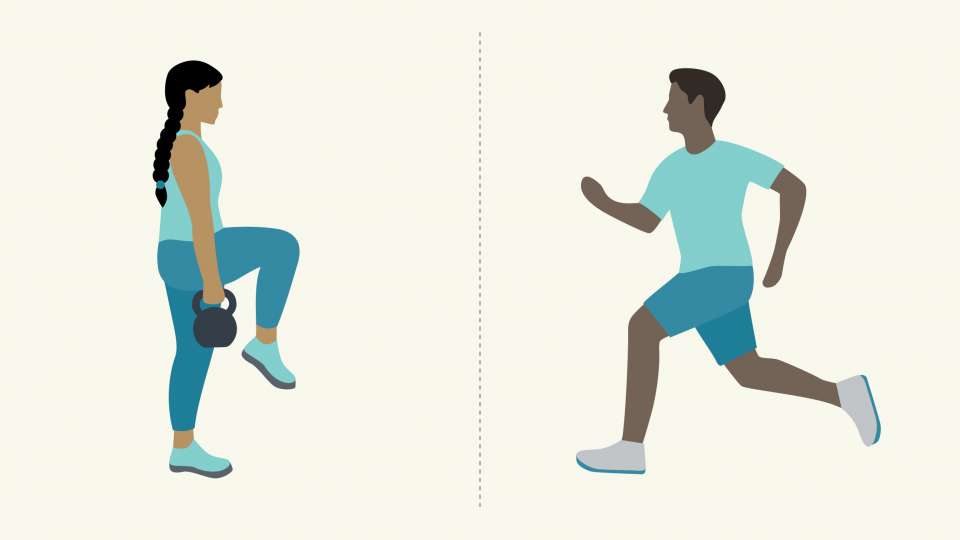
When deciding how to get your sweat on, do you reach for a pair of dumbbells or your running shoes?
Each type of exercise — strength and cardio — has its own benefits, but incorporating both into your workout schedule can be even better for your health.
Dr. Christopher McMullen, a sports medicine doctor at Harborview Medical Center and The Sports Medicine Clinic at South Lake Union, explains the difference between cardio and strength workouts and shares how to strike the best balance between the two forms of exercise.
The difference between cardio and strength
“In general, cardio exercise works to improve cardiovascular adaptations that increase oxygen consumption,” says McMullen. “Strength exercises work at the level of the muscles and the nerves controlling those muscles to improve strength and neuromuscular control: balance and coordination.”
In other words, when you choose a cardio exercise like walking, oxygen is used to provide your body with continuous energy for a while. This type of exercise improves your endurance (your ability to work out for an extended period of time).
On the flip side, strength exercises like weightlifting put stress on your muscles, which causes them to adapt and get stronger.
Why both are important for your overall fitness
Cardio and strength training play different — and important — roles in our health and fitness.
“Cardio training improves endurance, oxygen utilization efficiency, and cardiac and respiratory function,” explains McMullen. “Strength training increases muscle size and strength, enhances coordination, and is utilized for preventing and rehabilitating from injury.”
The American College of Sports Medicine (ACSM) recommends both forms of exercise in their physical activity guidelines: 150 minutes of moderate intensity aerobic activity — such as walking, going on a bike ride, jogging or even mowing the lawn — per week and muscle strengthening activities two or more days per week.
Those 150 minutes can be broken out into bite-sized workouts such as 30 minutes a day for five days a week — or any combination that fits your schedule. And if you have to miss a workout, or can’t fit in the full 150 minutes, don’t stress. Any amount exercise is better than none, and you’ll still get health benefits from the exercise you do.
“Each type of exercise has been shown to be beneficial for managing, treating and preventing a range of health conditions including diabetes, hypertension, arthritis, cancer and depression, just to name a few. The combination of both types of exercise may enhance these benefits,” says McMullen.
An added bonus: injury prevention
In addition to their vast health benefits, incorporating both strength and cardio into your workout schedule can reduce your risk of injury.
That’s because mixing up the types of workouts you do gives your body a break from the repetitive movements of cardio exercises (such as the motions of running, cycling or swimming), while strengthening and stabilizing muscles. A win-win scenario.
“For example, I suspect the risk of injury is lower in someone going on four runs per week with two days of resistance training versus someone running six days per week with no resistance training,” says McMullen.
The ACSM suggests having a balance of two-thirds cardio workouts to one-third strength training, but don’t worry if your strength-to-cardio ratio isn’t exactly such.
“The most important thing is that you have some mix of exercises and that you’re doing something you enjoy,” says McMullen. “If you hate lifting but love running, then definitely run — just try to mix a couple sessions of strength training in there as well because it will make you a better runner.”
What exercises count as cardio or strength?
If you find it helpful, you can use the ACSM’s guidelines to shape your weekly workout schedule. But which exercises fall under each category?
McMullen helps sort some exercises into each bucket.
“Yoga, Pilates, and barre are good examples of body weight strength training,” he says. “High intensity interval training (HIIT), cycling, running, swimming and boxing are generally more cardio than strength training but obviously there can be some mix.”
In general, your goal for cardio exercise should be to feel an increase in your breathing and heart rate. The goal for strength workouts is to feel muscle fatigue.
That means an activity like cross-country skiing would fall under the cardio category, whereas weightlifting would fall squarely in the strength category. Think about if your activity of choice makes your breathing rate increase or if it makes your muscles burn, and use that as a guide.
Creating a workout schedule
If you’re looking to create your own workout schedule, you can use the ACSM’s recommendations as a guide: 150 minutes of moderate-intense activity per week, plus two workouts that incorporate some strength exercises.
Next, select your workouts: walking, HIIT, Pilates, barre, boxing, running, cycling, yoga — the list goes on. Just remember that you want a mix of exercises that get your heart rate up alongside some that work your muscles.
Now all that’s left is pushing your living room coffee table to the side so you can start moving your way to a healthier you.
Before starting a new exercise routine, it's a good idea to talk to your doctor — especially if you have any health conditions or are recovering from COVID-19.

 Healthy ideas for your inbox
Healthy ideas for your inbox






